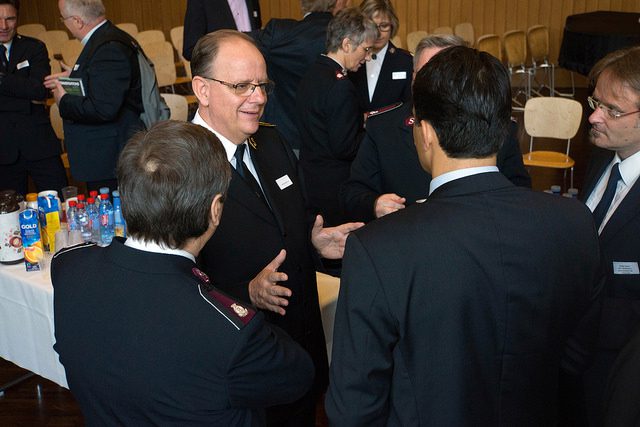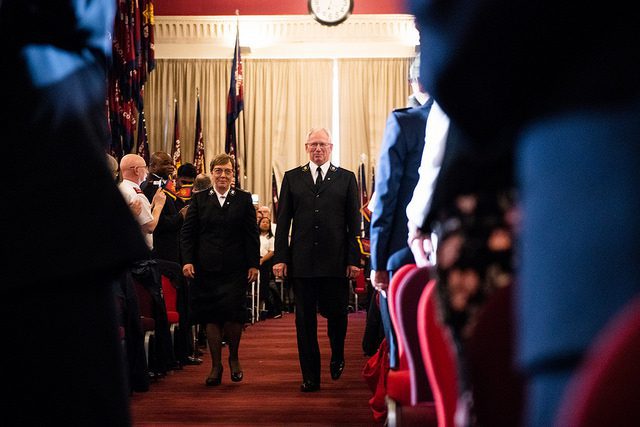Listen to this article
Listen to this article
Loading
Play
Pause
Options
0:00
-:--
1x
Playback Speed- 0.5
- 0.6
- 0.7
- 0.8
- 0.9
- 1
- 1.1
- 1.2
- 1.3
- 1.5
- 2
Audio Language
- English
- French
- German
- Italian
- Spanish
Open text
nepal earthquake ministry moves to long-term. six months after a 7.8-magnitude earthquake damaged or destroyed more than 700,000 dwellings in nepal, with the loss of more than 8,500 lives, the salvation army international emergency services team is transferring recovery operations in the country to a new projects and development team. nine projects are completed to date, with seven more winding down. the last international emergency team member is scheduled to depart kathmandu nov. 5, when a new team will move in with the specific task of working alongside local salvation army leaders and members to continue the community ministry in a country that is still coming to terms with the devastating disaster. six new long-term projects are already in preparation under the new projects and development team leader, captain richard vanlalnghaka from the india eastern territory, who is already in place and working with the emergency team members to learn about the most pressing needs and to ensure as smooth a handover as possible. “this august, jayandra—a dynamic young man, a leader in his community and a tireless worker for his neighbors—took us on a tour through the ruins of what had been a thriving community with centuries-old history,” said international emergency services deployee mary jane phelan, from the usa eastern territory, who has worked primarily with camps for internally displaced people in bhaktapur. “we saw piles of bricks and dried mud, half walls remaining of what had been a complex warren of homes, and stray dogs roaming the rubble. no people.”. solar lights at kwopa following the earthquake, the salvation army provided food, tarpaulins and tents; built temporary learning centers and houses; constructed septic tanks and toilets for camps, communities and schools; managed refugee camps; provided thousands of quilts and blankets, hundreds of hygiene kits and kitchen sets, clothing and school books. sometimes it has acted independently and at other times with trusted nepali non-governmental organization (ngo) partners, whose intimate knowledge of nepali culture and resources have informed the team’s actions and increased the value of each dollar spent. “the community members were living in a nearby camp called sanobyasi, where the salvation army has provided everything possible to facilitate a life with dignity for the 70 families sheltering there,” phelan said. “and yet, as we prepare to leave nepal, their future is still unsecured.”. this is evident through gopal g., who built a solar lighting system with funds from the salvation army that provides light in his community. he wrote with thanks while expressing continued difficulties there: “you and your team appear as a messenger of god to uplift our life…in previous days bhaktapur municipality had provided us drinking water…by truck but due to shortage of petroleum, vehicle is not operating…we are facing problem of scarcity of water.”. phelan explained that the fuel crisis in nepal affects every project and every community. “the quilt store has to close; cement vendors have no product; propane for cooking runs out; ngos can’t reach target villages,” she said. “a desire to somehow make it all right lingers, but the international emergency services team leaves the country having changed thousands of lives and with an enormous sense of gratitude for the support it has received.”.
Open context player
Close context player
Plays:-Audio plays count
nepal earthquake ministry moves to long-term. six months after a 7.8-magnitude earthquake damaged or destroyed more than 700,000 dwellings in nepal, with the loss of more than 8,500 lives, the salvation army international emergency services team is transferring recovery operations in the country to a new projects and development team. nine projects are completed to date, with seven more winding down. the last international emergency team member is scheduled to depart kathmandu nov. 5, when a new team will move in with the specific task of working alongside local salvation army leaders and members to continue the community ministry in a country that is still coming to terms with the devastating disaster. six new long-term projects are already in preparation under the new projects and development team leader, captain richard vanlalnghaka from the india eastern territory, who is already in place and working with the emergency team members to learn about the most pressing needs and to ensure as smooth a handover as possible. “this august, jayandra—a dynamic young man, a leader in his community and a tireless worker for his neighbors—took us on a tour through the ruins of what had been a thriving community with centuries-old history,” said international emergency services deployee mary jane phelan, from the usa eastern territory, who has worked primarily with camps for internally displaced people in bhaktapur. “we saw piles of bricks and dried mud, half walls remaining of what had been a complex warren of homes, and stray dogs roaming the rubble. no people.”. solar lights at kwopa following the earthquake, the salvation army provided food, tarpaulins and tents; built temporary learning centers and houses; constructed septic tanks and toilets for camps, communities and schools; managed refugee camps; provided thousands of quilts and blankets, hundreds of hygiene kits and kitchen sets, clothing and school books. sometimes it has acted independently and at other times with trusted nepali non-governmental organization (ngo) partners, whose intimate knowledge of nepali culture and resources have informed the team’s actions and increased the value of each dollar spent. “the community members were living in a nearby camp called sanobyasi, where the salvation army has provided everything possible to facilitate a life with dignity for the 70 families sheltering there,” phelan said. “and yet, as we prepare to leave nepal, their future is still unsecured.”. this is evident through gopal g., who built a solar lighting system with funds from the salvation army that provides light in his community. he wrote with thanks while expressing continued difficulties there: “you and your team appear as a messenger of god to uplift our life…in previous days bhaktapur municipality had provided us drinking water…by truck but due to shortage of petroleum, vehicle is not operating…we are facing problem of scarcity of water.”. phelan explained that the fuel crisis in nepal affects every project and every community. “the quilt store has to close; cement vendors have no product; propane for cooking runs out; ngos can’t reach target villages,” she said. “a desire to somehow make it all right lingers, but the international emergency services team leaves the country having changed thousands of lives and with an enormous sense of gratitude for the support it has received.”.
Listen to this article















